Executive Summary
IoT technology has the potential to transform the way retailers operate brick-and-mortar stores. We define IoT as any device that is Internet connected, capable of sending information to a cloud storage system and/or can interact with other Internet-connected devices. In this report, we focus only on physical stores, excluding the supply chain.
We distinguish between two types of solutions according to the main function of the connected device: 1) technology that tracks inventory and/or consumer behaviour—one example is RFID-enabled devices that track locations of items in-store; and 2) technology that interacts with consumers—for example smart mirrors that can detect what a customer tries on and interact with them by suggesting different colors or other items.
The applications of IoT technology to brick-and-mortar store environments bring many advantages to retailers, such as making operations more efficient thanks to the connected devices’ ability to track inventory levels in real time, or the possibility of improving the customer’s store journey by increasing the merchandise engagement through devices such as smart mirrors.
Companies such as Amazon, Walmart and Rebecca Minkoff are applying IoT technology in their physical stores. Amazon tested a new grocery store format that uses artificial intelligence (AI) to provide a checkout-free shopping experience, while Walmart plans to introduce a smart shopping cart that helps shoppers to navigate through the store and find products on the shelves.
Li & Fung’s retail-technology firm Catalyst and Dutch tech company Smartrac offer further IoT products to help retailers manage inventories more efficiently and engage with customers. For example, Catalyst’s Smart Screen is a touch screen that allows users to interact with their garments on the screen, while Smartrac’s Metrics is a retail store optimization system that uses sensors to track store data.
IoT offers many opportunities for retailers to improve efficiency, increase consumer engagement and ultimately generate more revenue from in-store sales. When implementing strategies to adopt IoT technology in-store, we believe that retailers should: 1)act fast, as the competition is moving quickly towards adoption;2) set up clear policies concerning the handling of consumer data, as the data gathered by IoT technology could raise issues in terms of data protection or compliance regulations; and 3) endeavour to work with suppliers that can embrace the increased efficiency achieved by the digitalization of store operations.
Introduction
IoT technology has the potential to transform the way retailers operate their brick-and-mortar operations. Our definition of IoT is any device that is Internet connected, capable of sending information to a cloud storage system and/or can interact with other Internet-connected devices. While simpler technologies, such as beacons, do not strictly fall within this definition, we nevertheless summarize these in this report, for completeness.
IoT applications in retail consist of connected devices mainly used to track inventory and consumer behavior or to improve the consumer’s shopping experience by making it more engaging. This report focuses only on in-store IoT usage and does not consider the retail supply chain or logistics.
Applying IoT technology to a physical store environment can increase the efficiency of operations and unleash new revenue opportunities, among other advantages.
Here, we provide examples of how retailers, including Amazon and Walmart, are changing store-based retailing through IoT. We also illustrate IoT solutions that two firms, Catalyst and Smartrac, offer to retailers.
Finally, we formulate a series of recommendations that retailers should consider when implementing strategies to adopt IoT technology in-store.
- Readers may also be interested in our report, An Overview of the Digitalization of the Apparel Supply Chain, which can be found on FungGlobalRetailTech.com.
IoT in Retail: Tracking Store Performance and Interacting with Customers
We can distinguish between two core types of IoT retail technology, according to the main function of the connected devices:
- Technology that tracks inventory and/or consumer behavior: This includes devices with radio-frequency identification (RFID) sensors that can track the location and movement of items in-store, as well as track consumer behavior in-store.
- Technology that interacts with customers: This includes devices that make shoppers’ experience easier and more engaging, such as smart mirrors that enable customers to virtually try on clothing.
The application of IoT devices in stores is part of the broader trend that is seeing the adoption of technology in brick-and-mortar operations. In Figure 1, we list selected technologies that are finding applications in brick-and-mortar stores. Some of those listed are borderline IoT or may not be considered IoT within our definition, but they are adjacent to and, in some cases, interchangeable with IoT products. Beacons, for example, operate a relatively simple system of localized Bluetooth transmissions; the “work” is done by the user’s smartphone in response to those transmissions.

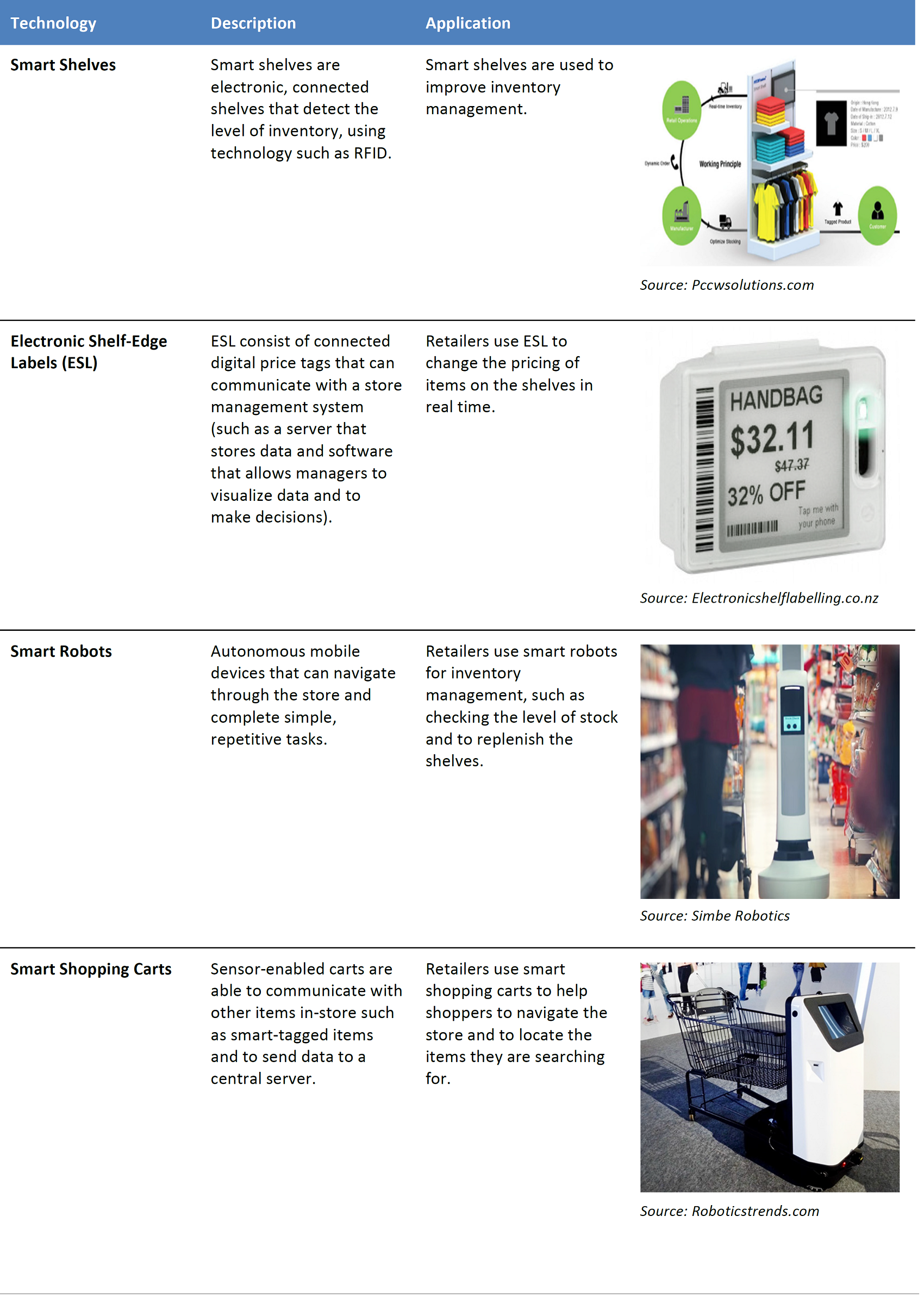
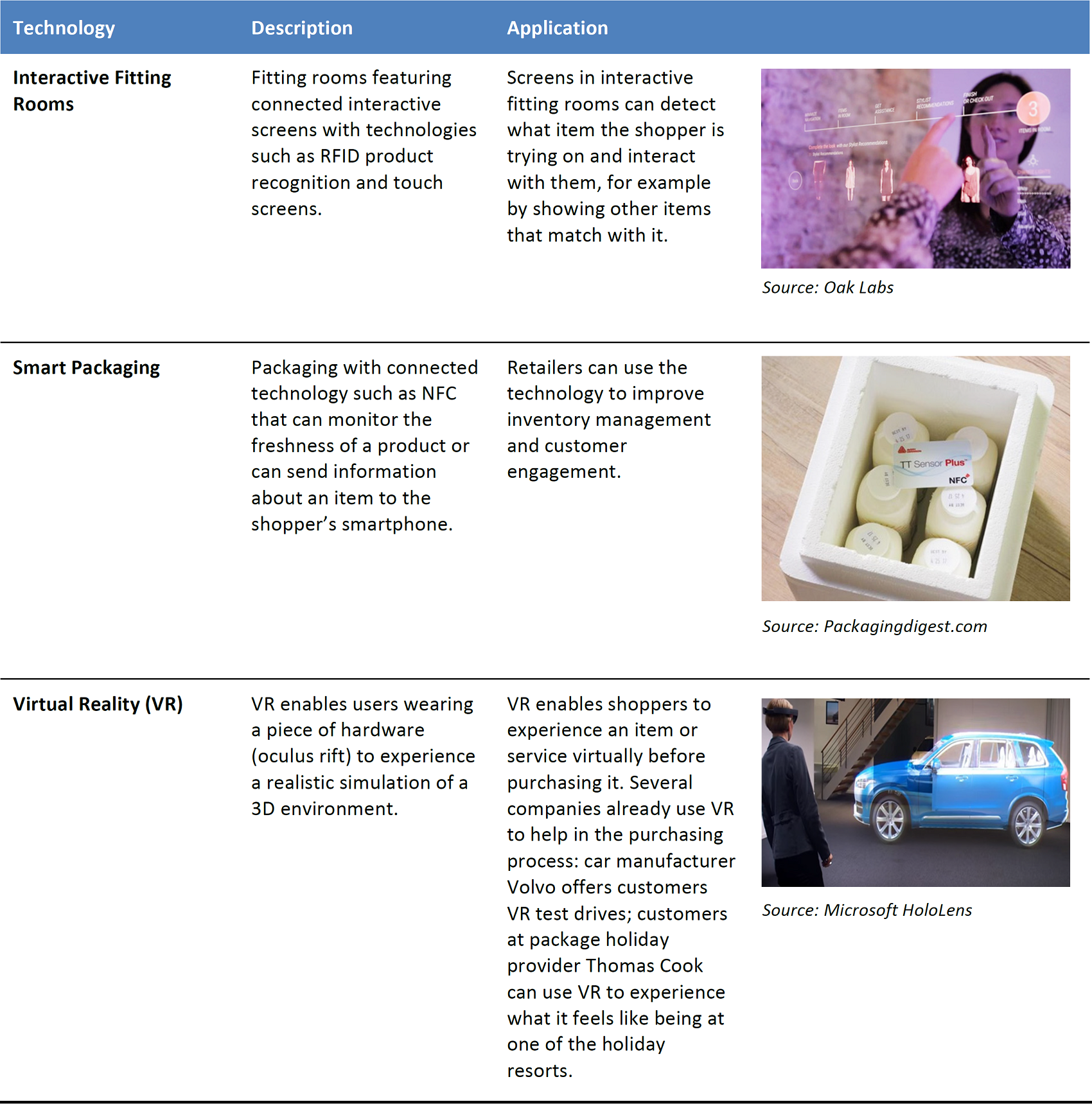
Source: Fung Global Retail & Technology
Advantages of IoT in Retail
Essentially, the application of IoT technology helps retailers make inventory management more efficient, measure store performance and improve the customer experience. In particular, IoT in retail can bring the following advantages:
- Optimization of store operations: A major advantage of IoT in retail is the digitization of in-store inventory. This makes it possible for retailers to track inventory levels and location of items in-store at any time in order to avoid misplaced stock. This improves store readiness, increases transparency and visibility of the operations and makes it possible to run systems that improve efficiency, such as automated alerts for stock replenishment.
- In-store analytics: Data generated by tracking the movement of items in-store and consumer behavior makes it possible to record metrics such as conversion rates and to make decisions to improve store performance such as increasing the visibility of the best-performing items. For example, using sensors to track the movement of items in-store—such as which items are tried on and brought to the checkout for purchasing—can help managers improve store layout by placing more popular products in high-traffic areas.
- Closer integration with the rest of the supply chain: In-store inventory tracking through IoT enables closer integration with other stages of the supply chain such as distribution, supporting more efficient operations. We provide an overview of the benefit of an integrated apparel supply chain through digitalization in our report. An Overview of the Digitalization of the Apparel Supply Chain
- Improved consumer experience: In-store connected technology increases merchandise engagement—for example by using smart mirrors that enable customers to virtually try on items or through NFC tags that send information about an item to the customer’s smartphone.
- New revenue opportunities: By increasing the opportunities for customers to connect and interact with retailers, IoT can help retailers grow revenues. For example, using in-store digital screens, shoppers could order sizes or colors that are not in stock in-store.
In Figure 2, we illustrate a tangible example of how IoT technology improves retail operations—comparing the level of inventory accuracy between barcoded and RFID systems.
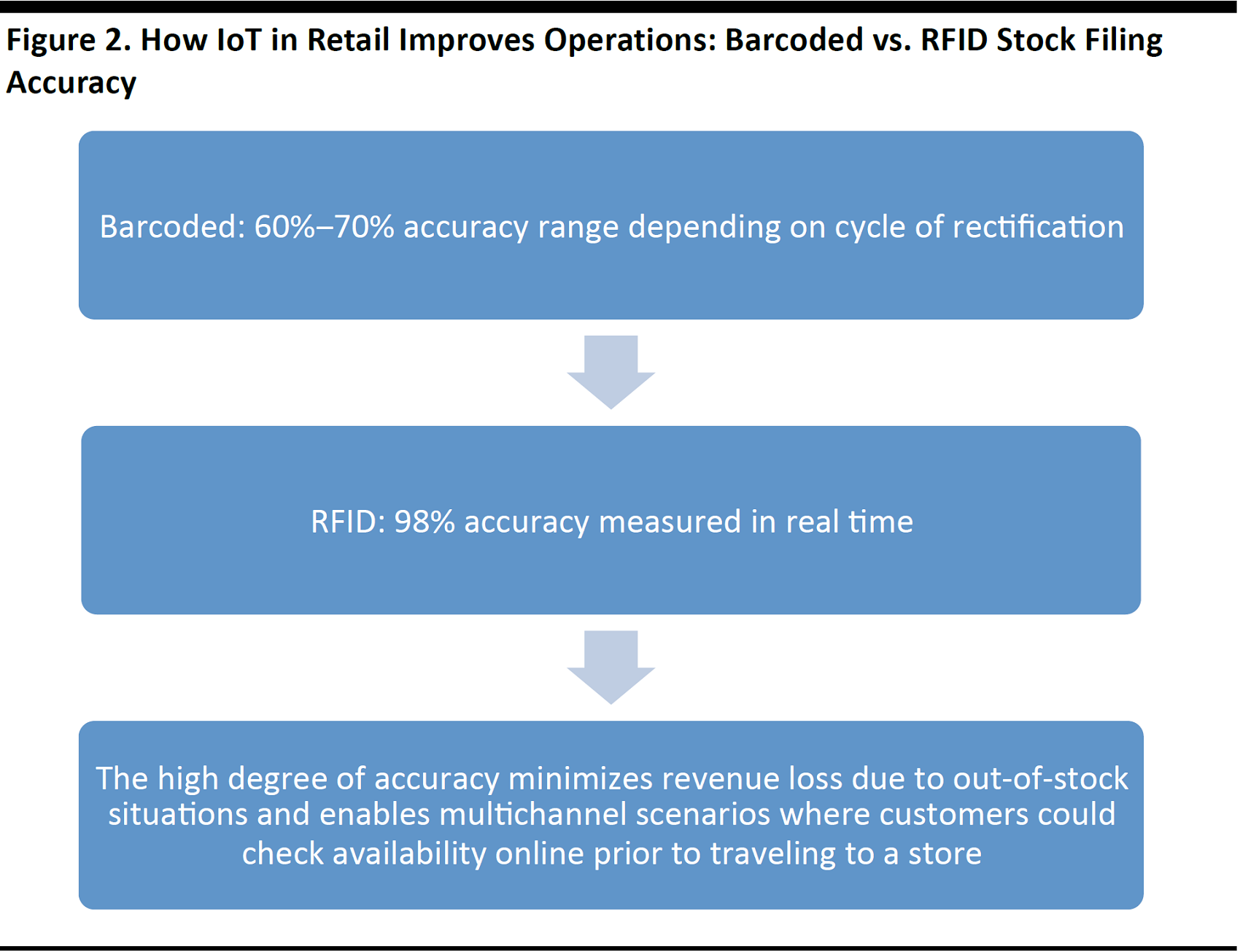 Source: smartrac-group.com
Source: smartrac-group.com
By increasing the efficiency of retailers’ operations, IoT generates value growth for the retail industry as a whole. The adoption of IoT technologies is expected to bring to the retail industry an estimated total economic benefit of £4.5 billion (US$5.6 billion) in the period from 2015 through 2020, according to the business analytics software organization SAS Institute. However, unlike the brick-and-mortar-store focus of this report, that total is likely to incorporate benefits yielded in the retail supply chain and logistics.
Technologies that Can Change Store Retailing
IoT in retail has the potential to transform the way brick-and-mortar stores operate, how they are managed and how they interact with customers. Signs of the profound impact that digital technologies have on brick-and-mortar operations are already visible. In particular, the new concept store Amazon Go shows how to provide a frictionless grocery shopping experience with the use of AI.
Another remarkable application of IoT in retail is VLC, which promises to revolutionize the way the retailer engages with the shopper in-store. Other examples of how IoT changes the way customers shop in brick-and-mortar stores include Rebecca Minkoff’s connected store, Razorshop by Razorfish ShopWithMe by With.Me, and Walmart’s and Panasonic’s Smart Shopping Cart solutions. In this section, we provide short profiles for each of these innovative concepts.
Amazon Go: The Store Run by AI
On December 5, 2016, Amazon announced the launch of Amazon Go, a new concept store without checkout lines. Amazon Go use AI to provide a frictionless shopping experience. The idea is to eliminate waiting time and lines at the checkouts by eliminating physical checkouts.
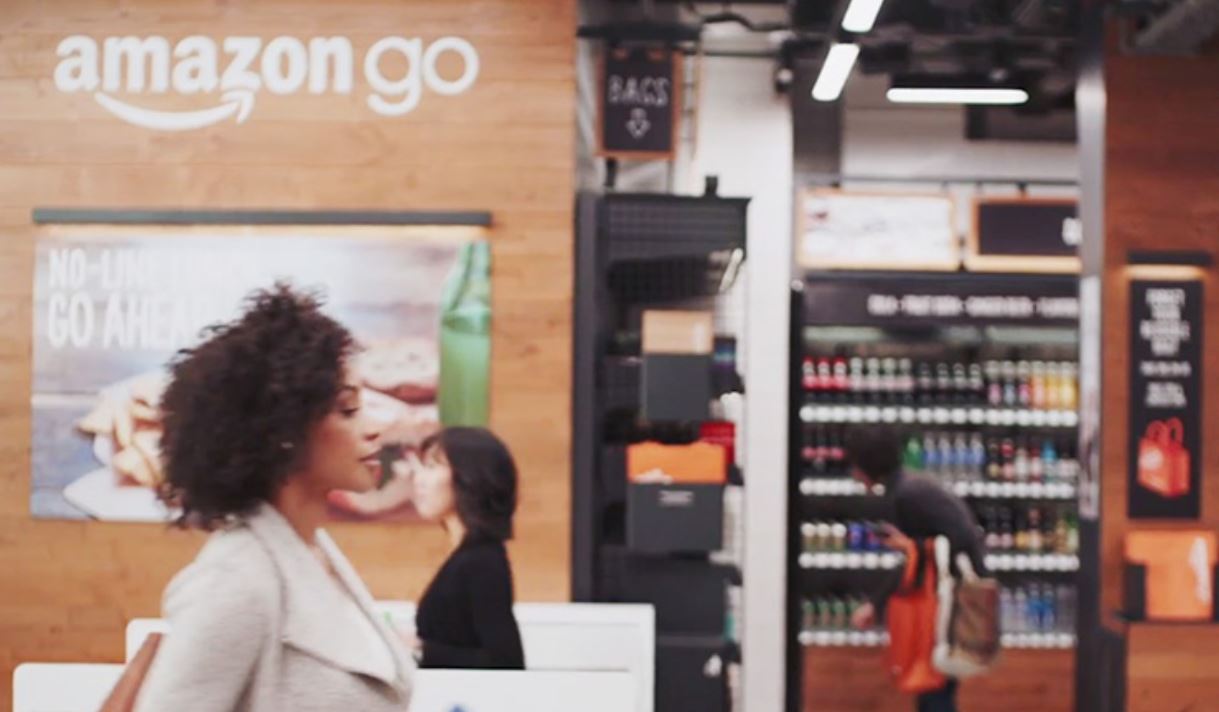
Source: Amazon.com
Using an Amazon Go app, shoppers swipe their smartphones on turnstiles as they enter the store. A system of computer vision, sensor fusion and deep learning detects which products the shopper picks up and which ones are returned to the shelves and charges the customer accordingly. The total balance is then charged on the shopper’s Amazon account. The customer can just walk out, as payment will be taken automatically from the bank card filed with the account. Amazon points out that similar technology is being used in self-driving cars.
The first, 1,800-square-foot store is in Seattle. At the time of writing, the store is still not open to the public. The opening is expected in early 2017, according to media reports.
Engage with Shoppers Through Light with VLC
VLC is a technology that uses light sources such as LED light bulbs to send information through visible light that can be received and read by devices, including smartphones, through their camera. The system can act as an indoor positioning system. In brick-and-mortar retailing, VLC can be used to send location-based notifications to shoppers’ smartphones—for example information about promotions or directions to help customers navigate through the store and locate the items they are looking for.
In 2015, French retailer Carrefour introduced VLC in its hypermarket EuraLille in Lille, France. The technology, from Dutch electronics firm Philips, was tested by the retailer as part of a promotional campaign “Promo C-où” to help consumers locate promotional offers in-store. Through an app, shoppers could compile a shopping list of items on offer. Once in-store, VLC would send directions to the customers’ smartphone to locate the items. The test lasted until the end of 2016, when the promotion ended.

Source: Philips
Rebecca Minkoff Connected Store
Fashion firm Rebecca Minkoff operates a Connected Store in New York that features connected walls—a system of screens through which the shopper can browse the collection and order items to be sent to the fitting room by a store associate. The fitting rooms feature digital mirrors—mirrored displays that use RFID to recognize the items in the room and that suggest what other sizes or color are available in stock. Through the mirrors, the shopper can ask for other items to be brought to the fitting room, and request store personnel to send the selected items to the checkout for purchase. The digital mirror gathers data about the customers which will enable the device to give the shopper style recommendations based on their past shopping history.

Source: Digiday.com
Razorshop by Razorfish
US tech companies Razorfish and Adobe have developed Razorshop, a digital retail environment that enables the profiling of customers in order to positively influence their shopping behavior and provide them with a personalized shopping experience. The service combines a series of proprietary technology:
Bluetooth Low Energy Experience Platform (BLEEP): BLEEP recognizes a shopper’s smartphone and sends information about items in stock as the customer enters the store.
In-store Customer Engagement Application (ICE): ICEruns on tablets through which the store associate can browse information—stored in a secured cloud—about a customer’s shopping behavior, preferences and history.
Adobe Software: This is used by the solution to provide store managers with analytics to improve store performance and the customers’ shopping experience.
The smartshop also features other devices, including interactive displays through which the store associate can show the outfit options to customers based on their preferences.

Source: Razorfish.com
ShopWithMe by With.Me
ShopWithMe is an interactive store in Chicago developed by retail tech company With.Me. The outlet houses collections from TOMS Shoes and Raven + Lily, and features a 30-foot-long pixel wall with interactive shelves that can move toward customers as they browse. The system suggests items to shoppers according to their individual preferences, based on data gathered by the in-store technology which monitors the browsing behavior of the shoppers. Dotted throughout the store are interactive tables—tables with an interactive screen that gives information about items, which are RFID tagged, as the shopper places them in the proximity of the surface.

Source: Electric Runway
Walmart and Panasonic Smart Shopping Cart Solutions
Walmart: US retailer Walmart is collaborating with tech company Five Elements Robotics on the development of a smart shopping cart that will help shoppers navigate through a store to find products on the shelves. The cart operates through a network of sensors that send data to a central computer that tracks inventory and matches the customer’s shopping list with the available inventory. The central computer will then send directions to the smart carts about the location of the items on the list within the store. The patent was filed in March 2016, but the technology is still not operational in Walmart stores at the time of writing.
Panasonic: Japanese electronics firm Panasonic has developed a similar solution, a smart shopping basket designed to detect items in a cart and calculate the bill. At the checkout, the bottom of the basket opens up and the items slide into a shopping bag. The company tested the solution in a Lawson store in Osaka and announced that the system will be fully operational by February 2017, according to
The Wall Street Journal.
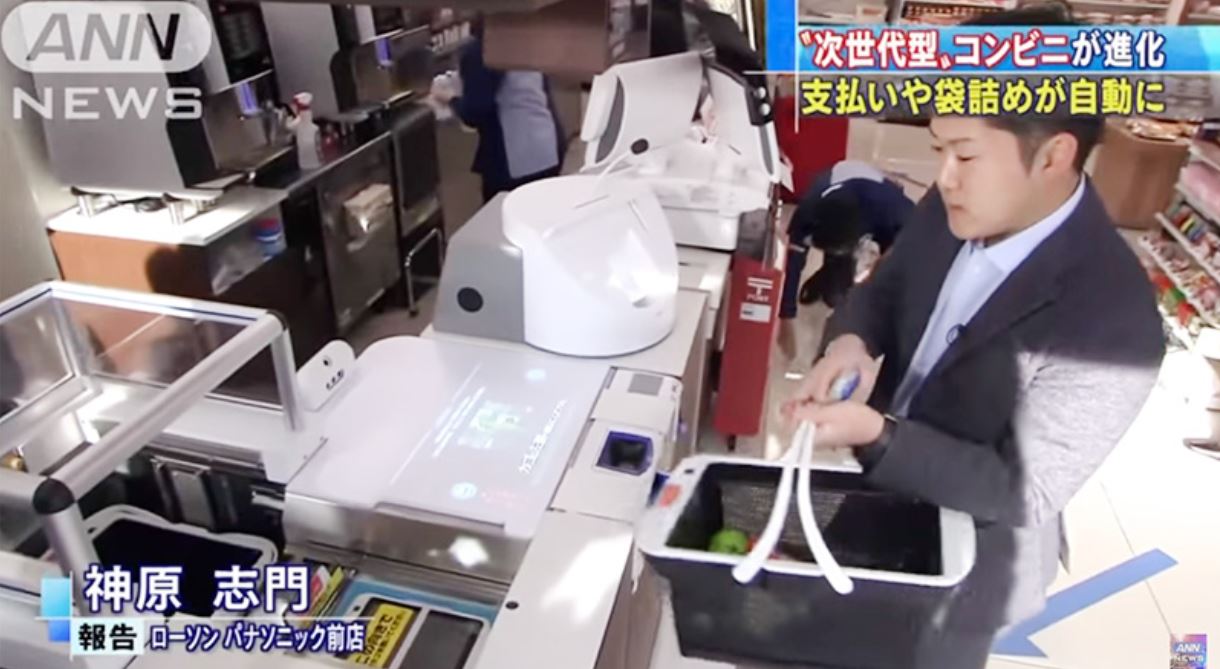
Source: ANN News
Further Examples of IoT Applications in Retail: Catalyst and Smartrac
In this section, we provide an overview of IoT products by two companies: Li & Fung’s retail tech company, Catalyst, and Dutch tech company Smartrac. The two companies are working together on a new RFID partnership to offer in-store product tracking.
Catalyst: Inventory Control for Retail
Catalyst provides innovative RFID products to help retailers managing retail inventories. Two of these products are Catalyst Scan and RFID Inventory Robot:
- Catalyst Scan: Catalyst Scan is an efficient inventory management product, consisting of an RFID handheld reader that uploads data directly to the cloud. The scanner pairs with a smartphone through which the user can open an app, create an inventory or continue an existing inventory and populate it by scanning the items. It also enables visual inventory, as information about the items—photos and description—can be retrieved from the cloud during the scanning.
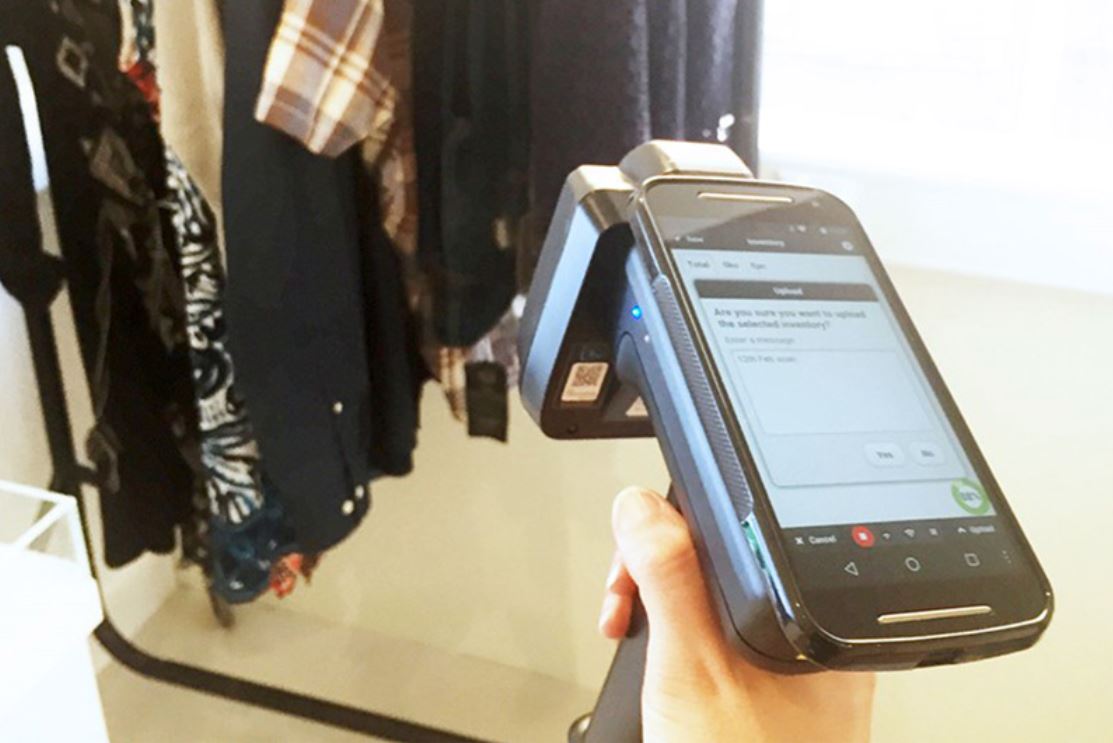
Source: catalyst-direct.com
- Catalyst Robot: The Catalyst Robot is an RFID inventory management product that consists of an autonomous and mobile robot capable of completing store inventories. The robot easily navigates around retail spaces and provides stock availability and location data on a regular basis.
Catalyst also provides RFID products that enhance customer engagement in-store and improve the shopping experience:
- Catalyst Smart Screen: An interactive touch screen that allows users to interact with their garment on the screen, view the ‘complete look’ and view the garment’s product information. To activate the screen, the customer only needs to hold the garment close to the screen, which detects the RFID tag attached to the garment and pulls associated content down from the cloud.
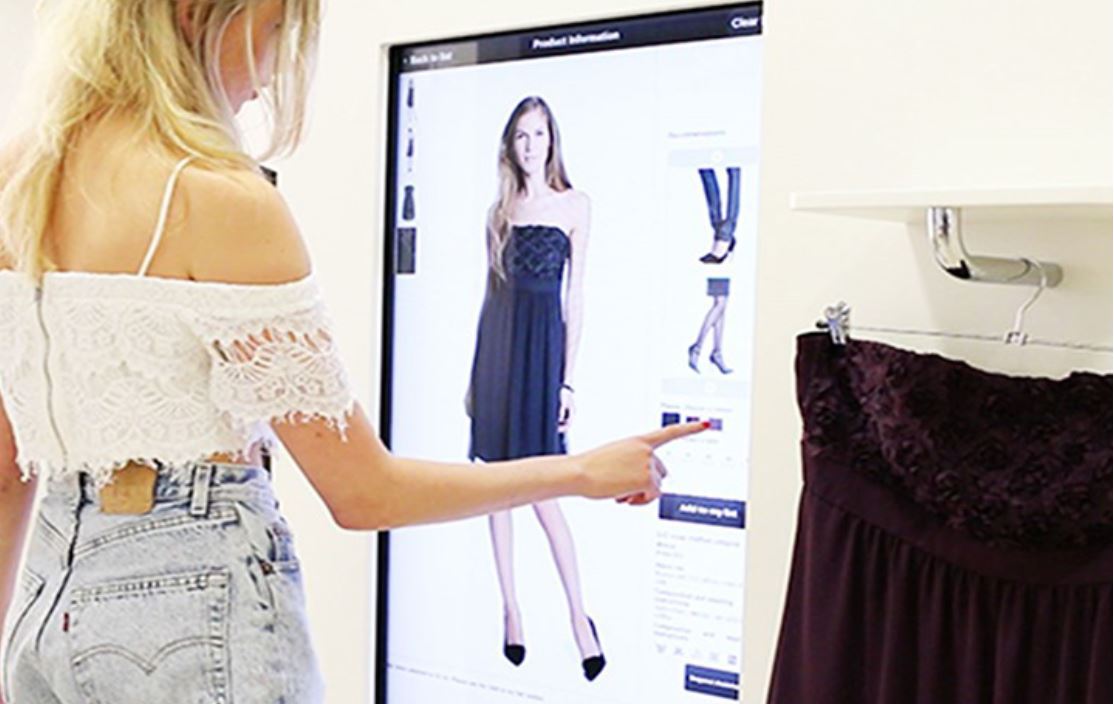
Source: catalyst-direct.com
Retailers such as Burberry and Rebecca Minkoff (as discussed earlier in the report) already use similar technology in their stores. Burberry’s Regent Street flagship store in London features digital mirrors that use RFID technology to identify the garment the shopper picks up and shows on the screen further information such as outfit ideas.
- Catalyst Smart Tray: A tray combined with an interactive touch screen. When a customer places a product that has an RFID tag on the Smart Tray, the latter displays a range of information, including product features and benefits. The technology is typically used for cosmetics or footwear.

Source: catalyst-direct.com
Smartrac Retail Store Optimization: Metrics
Dutch tech company Smartrac offers Metrics, a retail store optimization system that uses sensors to track store data.
Smartrac’s system can also show store managers what happens when an item is taken to the fitting room and how well employees are engaging with customers. The system provides brick-and-mortar retailers with a wealth of inventory information to improve stock keeping, displays, and sales conversion.
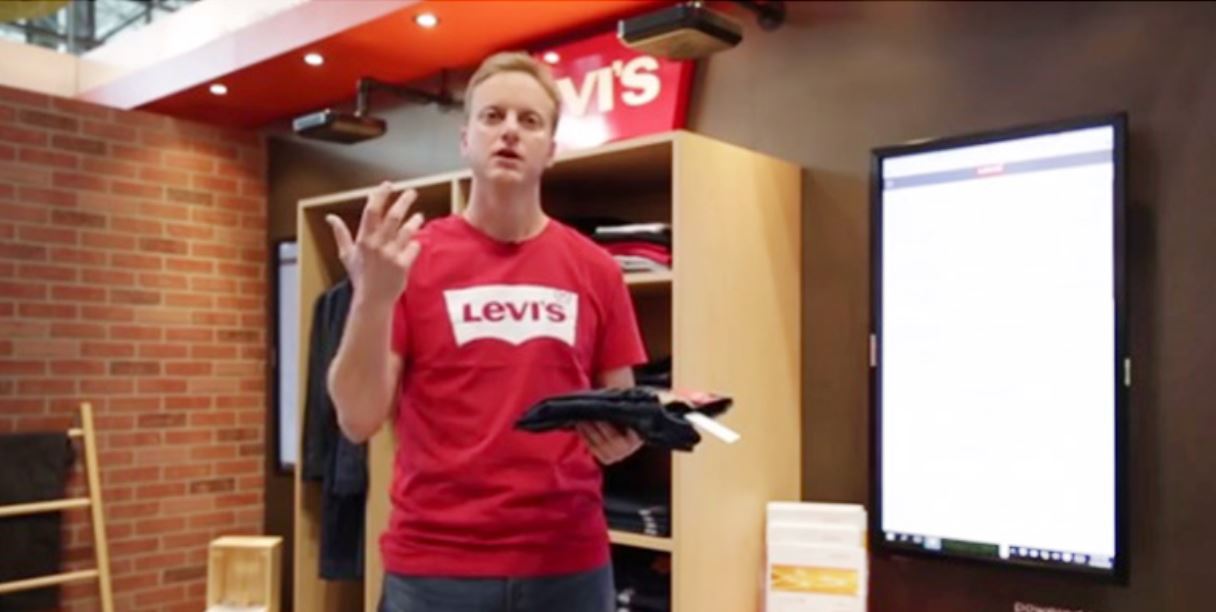
Source: smartrac-group.com
Metrics consists of a network of sensors that collect store data. Information is gathered through motion sensors, RFID devices and Point of Sales (POS) data feedback. All the information gathered is then stored in the cloud.
The system provides the same level of analytics available in an e-commerce environment, including:
- Insight to help executives improve store management.
- Actions for employees, such as alerts that tell when an item is out of place or when replenishment is needed.
Store managers can use the information to track KPIs, including:
- How long it takes to replenish the sales floor.
- How long it takes to stock an item that is received.
- How “clean” the store is(how many items are misplaced).
IoT systems such as Smartrac’s Metrics also enable executives to measure conversion from browsing or from trying on in fitting rooms. And managers can analyze how well employees engage with consumers in order to increase conversion.
Currently, retailers know what sells based on sales data. However, in-store IoT systems can give further information, such as identifying items with a low conversion ratio (items picked up many times, yet are not purchased often), or conversely, which items do not have enough visibility relative to their potential based on their conversion ratio. This information can help to improve the layout of the store by increasing the visibility of merchandise with potential for more sales.
Recommendations: Act Fast, Handle Data with Care, Review Relationship with Suppliers
IoT in retail offers many opportunities for retailers to improve efficiency, increase consumers’ engagement and ultimately generate more revenue from in-store sales. When implementing their strategies to adopt IoT technology in-store, we believe that retailers should consider the following: 1) act fast, as competitors are adopting new technologies; 2) set up clear policies on the handling of consumer data; and 3) redefine the relationship with other supply-chain stakeholders.
Act Fast, as Competitors are Adopting New Technologies
Retailers that wish to remain competitive should act fast and deploy an adoption strategy for IoT technology in-store.
IoT in retail is still in its early stage, but retailers are adopting technologies quickly. Only 4% of US-based apparel retailers had achieved full adoption of RFID tags as of June 2016, according to the Auburn University RFID Lab. However, the remaining 96% of retailers were working toward the achievement of full RFID adoption, as shown in Figure 3. Consequently, in the near future, we expect that most apparel retailers in the US will have RFID technology in-store.
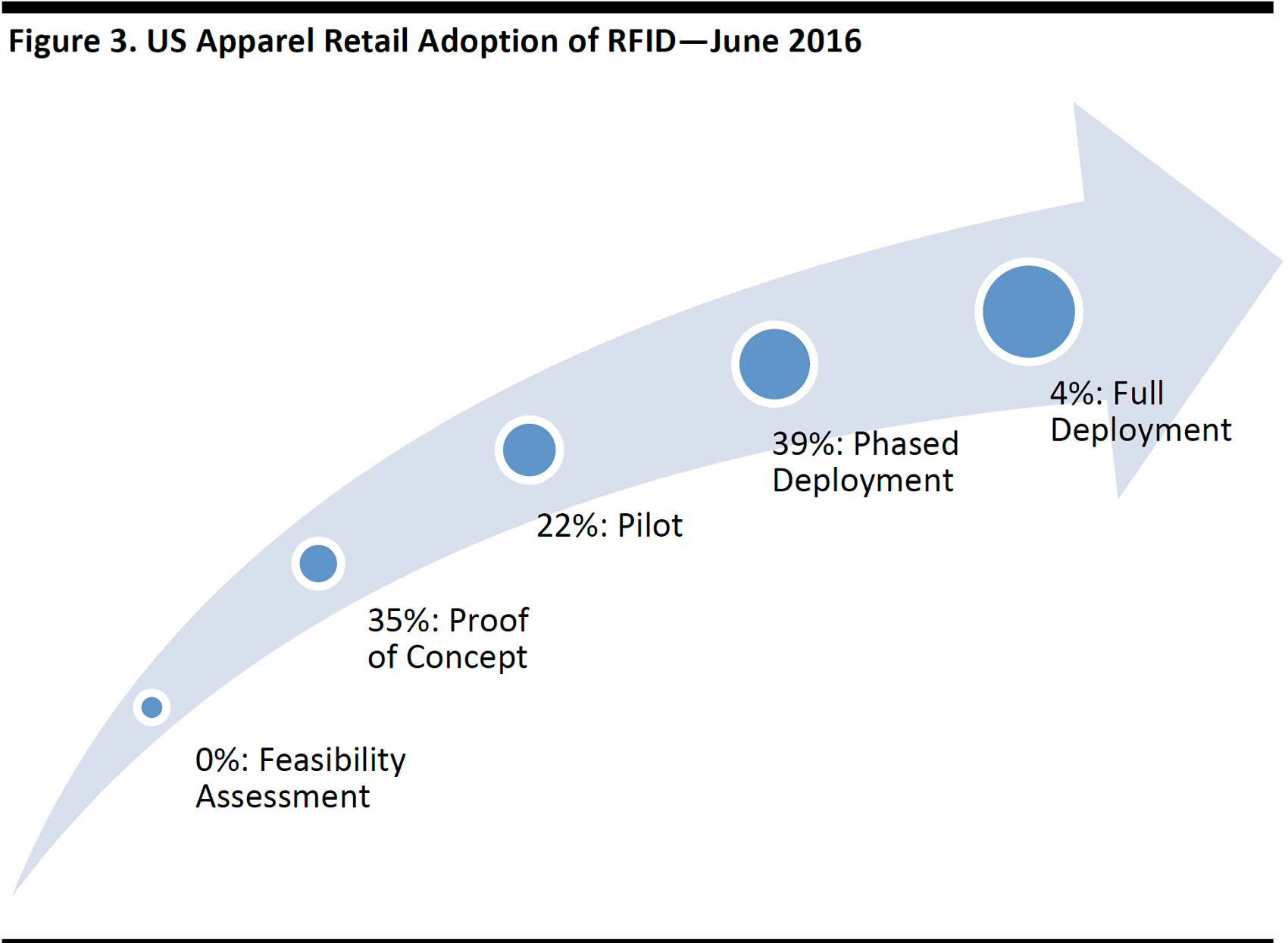
Source: Auburn University RFID Lab
Retailers are acting fast in adopting the technology: for instance, in the UK, retailers had a 21% IoT technology adoption rate in 2015, according to the SAS Institute. Considering the economic benefits in terms of increased efficiency that IoT brings to retail operations, it comes as no surprise that most players in the industry are undertaking strategies to adopt the technology.
Set UpClear Policies on the Handling of Consumer Data
Retailers that adopt in-store IoT technology need to consider the legal implications of tracking consumers’ data, make it clear to consumers when data is recorded and for what reasons, and define clear data handling responsibilities and compliance procedures within the organization.
The collection of consumers’ data that IoT in retail makes possible could raise concerns among shoppers. According to a survey undertaken by research organization ComRes, 69% of respondents voiced concerns about the collection and use of personal data by organizations through connected devices.
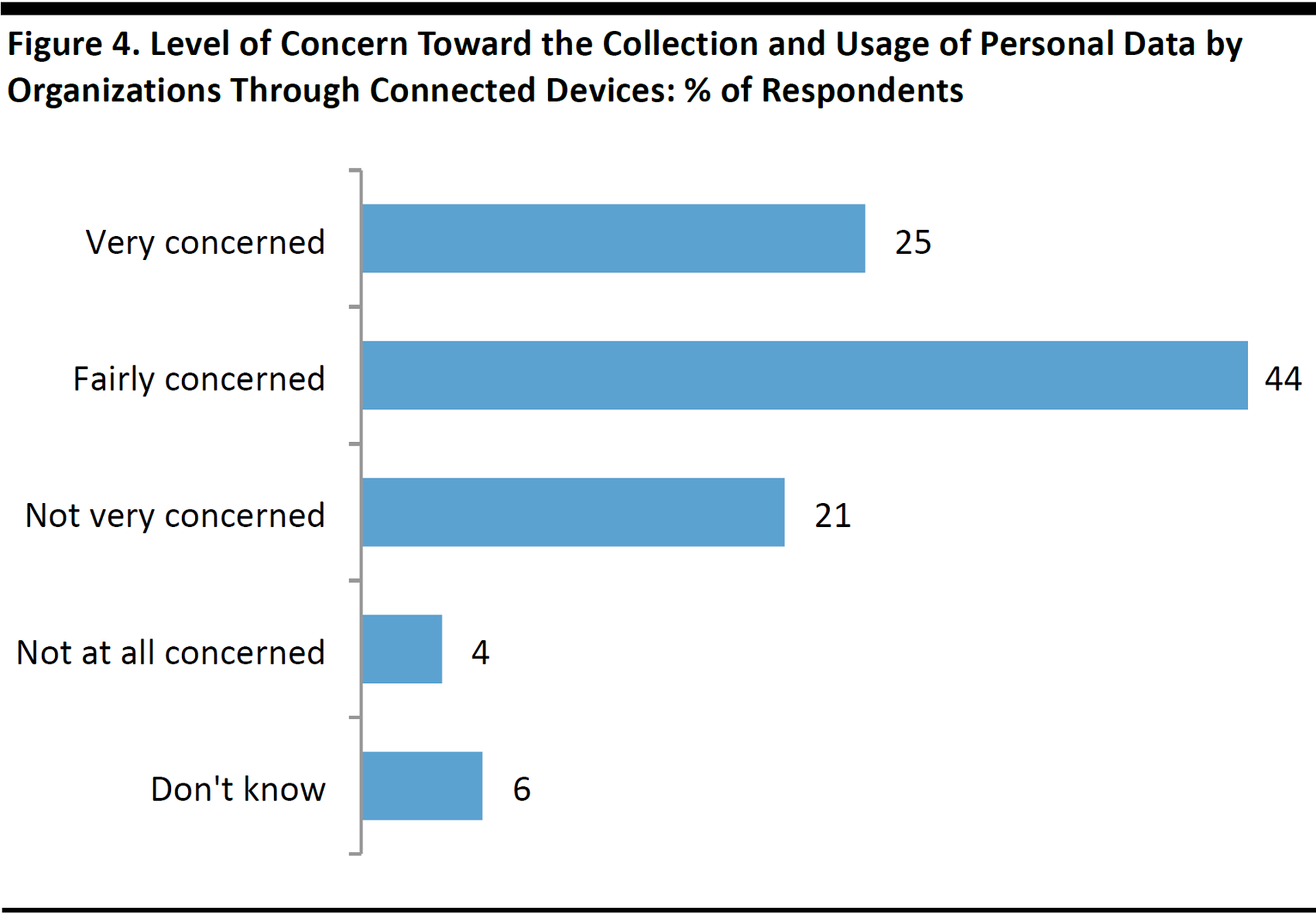
Base: 1,000 UK adults aged 18+. Period: February 18, 2015 to February 23, 2015.
Source: ComRes
Moreover, data protection regulations could undermine retailers’ ability to use data gathered by IoT technology for consumer behavior analytics. For example, the General Data Protection Regulation (GDPR), a new regulation that will regulate data protection in the EU and comes into effect from 2018, introduces more stringent provisions for organizations—including retailers—operating in the EU and using data processing technology.
Redefine the Relationship with Other Supply-Chain Stakeholders
Retailers adopting IoT technology should redefine the relationship with other stakeholders within the supply chain, and choose business partners with operations that are ready to effectively meet the requirements of the increased efficiency the technology brings to the retailer.
We have seen in the report how the IoT technologies that track in-store inventory can bring a closer integration and better coordination with the rest of the supply chain, making the retailers’ operations more efficient. For example, in-store sensors can be used to track inventory in real time and to process orders more swiftly. Figure 5 summarizes the closer integration between the retailer and the supplier enabled by IoT technology.
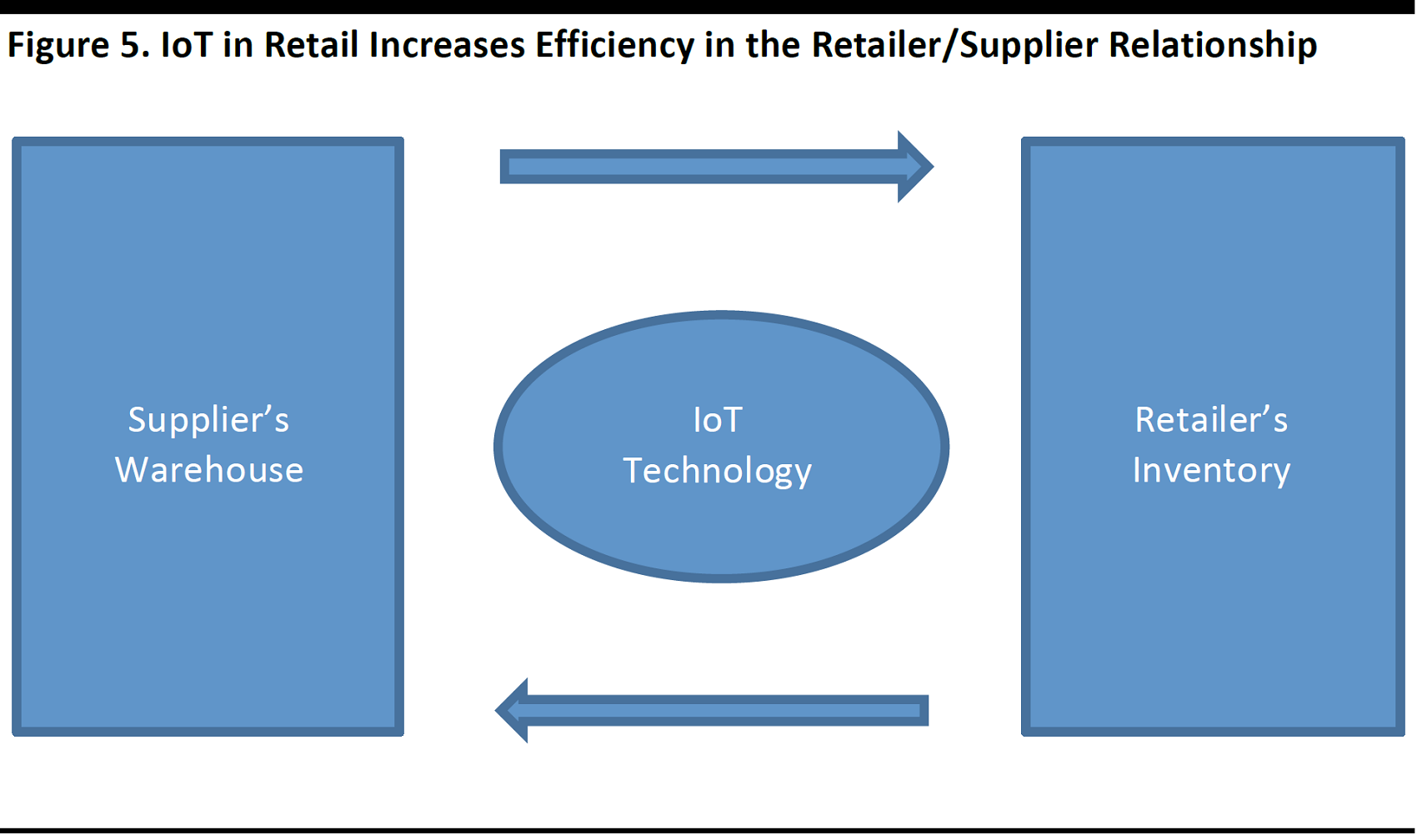
Source: Fung Global Retail & Technology
In order to capitalize on these advantages, retailers should partner up with suppliers that can receive and respond promptly and efficiently to the frequent orders triggered by the retailer’s real-time inventory tracking system.
Key Takeaways
IoT technology has the potential to transform the way retailers operate brick-and-mortar stores. RFID, NFC, and VLC are among the technologies offering promise to retailers.
IoT brings many advantages to retailers, such as making store operations more efficient due to the connected devices’ ability to track inventory levels in real time, or the possibility of improving the customer’s store journey by increasing the merchandise engagement through devices such as smart mirrors.
Companies such as Amazon, Walmart, and Carrefour are applying IoT technology in their brick-and-mortar operations. We can expect other retailers to follow suit, in a bid to catch up with the industry leaders.
Retailers looking to adopt IoT technology in-store need to consider the implications of handling shoppers’ data gathered through IoT technology in order to avoid data protection breaches. Moreover, retailers should also endeavour to work with suppliers ready to help them capitalize on the increased efficiency brought by IoT.




 Source: smartrac-group.com
Source: smartrac-group.com











